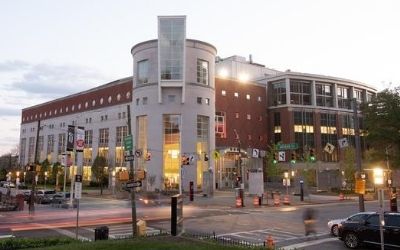
Between 6am-8am, M-F, enter the HSHSL through the Campus Center. The HSHSL’s front doors do not unlock until 8am. Show your UMB id to the guard at the Campus Center and enter the HSHSL through our connecting hallway.

601 West Lombard Street
Baltimore MD 21201-1512
Reference: 410-706-7996
Circulation: 410-706-7928

Between 6am-8am, M-F, enter the HSHSL through the Campus Center. The HSHSL’s front doors do not unlock until 8am. Show your UMB id to the guard at the Campus Center and enter the HSHSL through our connecting hallway.

The HSHSL will be closed Saturday, September 3 – Monday, September 5 for the Labor Day Weekend holiday.
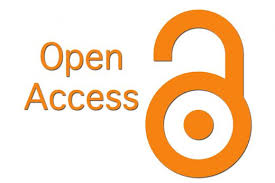
The White House issued new guidance that will speed progress toward curing diseases, preventing pandemics, mitigating climate change, and more.
From a statement issued by SPARC:
Washington, DC (August 25, 2022) – As a result of action taken today by the White House Office of Science & Technology Policy (OSTP), taxpayer-funded research will be immediately available for the public to freely access and fully use. The new guidance issued to all federal agencies will eliminate the current 12-month waiting period for access to research outputs, including articles and data.
“This is an enormous leap forward,” said Heather Joseph, Executive Director of SPARC, which has worked for more than two decades to accelerate open access to research. “For the first time, everyone will have free and immediate access to the results of all federally funded research to speed solutions for global challenges—from cancer to climate change.” Read the full statement.

August 29 – November 30, 2022
Regular Semester Hours
| Monday – Thursday | 6:00 am – 11:00 pm |
| Friday | 6:00 am – 8:00 pm |
| Saturday | 8:00 am – 8:00 pm |
| Sunday | 8:00 am – 8:00 pm |
Exceptions to Regular Hours
| Labor Day Weekend | September 3 – 5 | CLOSED |
| Thanksgiving Holiday | November 24 – 25 | CLOSED |
Blog post researched and written by Summer 2022 YouthWorks Intern, Anisah Allen. Anisah worked in the HSHSL’s Information Services and Historical Collections Departments. Anisah is a student at the University of Maryland Baltimore County. During her internship she completed the digitization and transcription of Margaret Bowen Rose’s 1936 School of Nursing Scrapbook.
The Health Sciences and Human Services Library Historical Collections’ strives to provide broad access to our diverse collections both in person and digitally. Materials in our collections appear as they originally were published or created and may contain offensive or inappropriate language or images and may be offensive to users. The University of Maryland, Baltimore does not endorse the views expressed in these materials. Materials should be viewed in the context in which they were created.
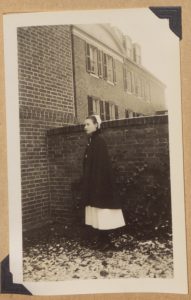 Scrapbooking in the 21st century has become somewhat of a lost art but remains a very powerful historical tool. With a combination of journal entries and photographs, they give a great deal of insight into not only the look and feel of the time period they were created, but also of the person who created them. Margaret Bowen Rose, possibly unknowing of this significance, created such a document for her Class of 1936 at the University of Maryland School of Nursing. The most exciting thing about this book’s donation is that our Historical Collections does not currently have yearbooks for the years of 1933-1946 at the University. Margaret’s unique perspective is the closest insight we have to the experiences of our students during that period.
Scrapbooking in the 21st century has become somewhat of a lost art but remains a very powerful historical tool. With a combination of journal entries and photographs, they give a great deal of insight into not only the look and feel of the time period they were created, but also of the person who created them. Margaret Bowen Rose, possibly unknowing of this significance, created such a document for her Class of 1936 at the University of Maryland School of Nursing. The most exciting thing about this book’s donation is that our Historical Collections does not currently have yearbooks for the years of 1933-1946 at the University. Margaret’s unique perspective is the closest insight we have to the experiences of our students during that period.
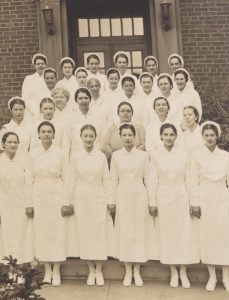 Included in the book are endearing descriptions of her classmates, photographs of them, and even a class prophecy showcasing their future goals after graduating. Though Margaret wanted to enroll in an Alaskan nursing program with classmate Vernice Bowling, both ended up enlisting in military service in the 40’s during the Second World War. Including herself and Vernice, four members of the class of ‘36 were stationed in Australia for one year working in a hospital setting and tending to wounded soldiers. As for those who did not enlist, some were married, while others worked at hospitals a bit closer to home. Margaret wrote about her duties in the School of Nursing Alumnae Association Bulletins, telling after necessary emergency care soldiers received “baths, food, rest, and mothering” from the nurses, who were honored to help.
Included in the book are endearing descriptions of her classmates, photographs of them, and even a class prophecy showcasing their future goals after graduating. Though Margaret wanted to enroll in an Alaskan nursing program with classmate Vernice Bowling, both ended up enlisting in military service in the 40’s during the Second World War. Including herself and Vernice, four members of the class of ‘36 were stationed in Australia for one year working in a hospital setting and tending to wounded soldiers. As for those who did not enlist, some were married, while others worked at hospitals a bit closer to home. Margaret wrote about her duties in the School of Nursing Alumnae Association Bulletins, telling after necessary emergency care soldiers received “baths, food, rest, and mothering” from the nurses, who were honored to help.
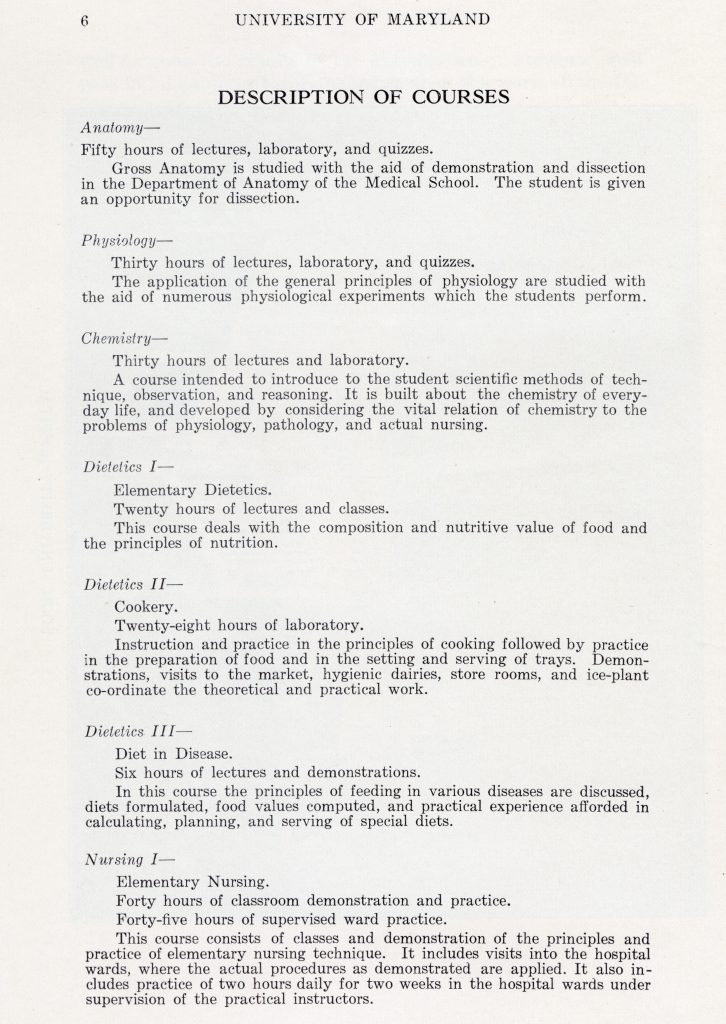 They would have been well prepared for their work abroad considering the experience they gained while still in university. A booklet can be found on page 66 of Margaret’s scrapbook giving details as to what students would be learning at the School of Nursing, with courses such as Materia Medica, Ethics, and Pathology. The program isn’t too dissimilar to what you could expect from a Bachelor of Nursing today, save for the perceived role of a nurse in hospital care. Classes found in the booklet seem to place a greater emphasis on the hospitality needs of the patient, whereas today’s course content encourages collaboration between doctors and nurses in diagnosis and treatment. The world of nursing has surely changed between Margaret Bowen Rose’s time and our own, and her 1936 scrapbook has proven itself invaluable as a window to the past.
They would have been well prepared for their work abroad considering the experience they gained while still in university. A booklet can be found on page 66 of Margaret’s scrapbook giving details as to what students would be learning at the School of Nursing, with courses such as Materia Medica, Ethics, and Pathology. The program isn’t too dissimilar to what you could expect from a Bachelor of Nursing today, save for the perceived role of a nurse in hospital care. Classes found in the booklet seem to place a greater emphasis on the hospitality needs of the patient, whereas today’s course content encourages collaboration between doctors and nurses in diagnosis and treatment. The world of nursing has surely changed between Margaret Bowen Rose’s time and our own, and her 1936 scrapbook has proven itself invaluable as a window to the past.
To see the full Scrapbook as well as other School of Nursing and UMB historical pieces check out our Digital Archive!
From the August 25, 2022 White House press release, “Today, the White House Office of Science and Technology Policy (OSTP) updated U.S. policy guidance to make the results of taxpayer-supported research immediately available to the American public at no cost.” Read the full press release here.
The Center for Data and Bioinformation Services (CDABS) will be holding an R workshop the last two Wednesday (21st & 28th) and Thursday (22nd & 29th) in September. All sessions run from 1:00pm to 4:00pm and meet online. Space is limited so register now!
R is an open-source programming language that is ideal for working with statistics and data. Here at CDABS, we love R for many reasons: It’s free, flexible, and friendly! It’s also a great tool for creating reproducible data analyses and visualizations.
In this series we’ll start with the basics of R and the RStudio environment, move to more complex data wrangling and visualization tasks, and finally look at the extended R ecosystem and tools for sharing your work with interactive reports, notebooks, and applications. Sign up for the whole series, or just the sessions that interest you most, but be advised that the later sessions will require at least a little familiarity with R.
See full session descriptions below and register here:
This session will provide a solid foundation in working with R and RStudio and lay the groundwork to enable participants to explore more advanced topics in R programming. No experience with R or programming is required.
Topics covered will include:
This session will introduce the concept of “tidy” data, and the versatile collection of packages known as the Tidyverse. Participants will get hands-on experience wrangling real datasets.
Topics covered include:
Prerequisites: Session one in this series, or have previous experience with base R.
Learn how to use the ggplot2, a robust Tidyverse package used to create high quality graphics for exploring and communicating your data. We will go beyond basic graphs and learn how to customize and annotate our graphs for more effective storytelling. Participants will have the best experience if they attended session two in this series or have some previous experience with R and the Tidyverse.
Topics covered include:
Prerequisites: Session two in this series, or have previous experience with R.
This session will provide a high-level overview of the vast ecosystem in R for reproducible research and creating interactive data visualizations. Users will learn about version control, packages available in R for creating reports, online books, and even blogs. There will also be an introduction to creating data applications/ dynamic dashboards using the Shiny package in R. Participants will have the best experience if they have some familiarity with R syntax and the RStudio interface.
Topics covered will include:
Prerequisites: Session one in this series, or have previous experience with R.
Questions? Contact: Amy Yarnell, data services librarian and Jean-Paul Courneya, bioinformationist at data@hshsl.umaryland.edu.
The Center for Data and Bioinformation Services (CDABS) is the University of Maryland Health Sciences and Human Services Library hub for data and bioinformation learning, services, resources, and communication
Sign up to get DABS delivered to your email or RSS feed.

How do you access HSHSL resources from off-campus? Click on the blue “Off-Campus Access” button on the upper right-hand side of the library’s website. for more information, click here.
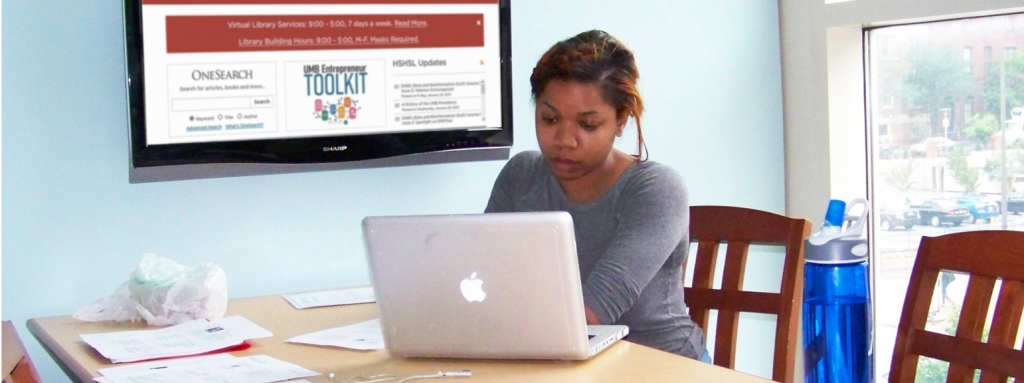
The HSHSL has 45 #StudyRooms available for use on the 2nd – 5th floors. Some are first come, first served while others are available to reserve. http://bit.ly/HSHSLStudyRoomRes
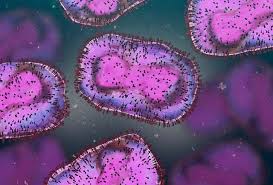
The National Library of Medicine (NLM) is working to expand access to literature and research related to the monkeypox virus. Follow the link for information about how to access this content.